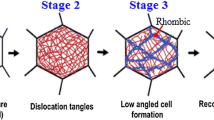Abstract
The formability of continuous cast 5052 alloy thin sheets from two different process schedules was examined. One was prepared in the laboratory by cold-rolling from a continuous cast thick plate followed by annealing (lab-processed sheet), and the other was produced by a new process involving hot-rolling followed immediately by in-line annealing (in-line annealed sheet). Tensile test results indicate that all the lab-processed sheets exhibit evident yield behavior. Increasing rolling reduction results in an increase of strength and a decrease of ductility in the lab-processed sheets due to increasing contribution of centerline segregation of second-phase particles. Both the lab-processed sheets annealed at 400 °C for 90 min and the in-line annealed sheets exhibit tensile elongation of more than 20% and two-stage strain hardening behavior. Compared with the lab-processed sheets, the in-line annealed sheet annealed at 454 °C has higher values of UTS and elongation. Furthermore, forming limit curves were determined. It is found that the level of the forming limit curve of the lab-processed thin sheet is lower than that of conventionally produced 5052-O Al, but close to that of 6111-T4 Al sheet. Moreover, the in-line annealed sheets have higher limit strains than the lab-processed sheets. These results demonstrate that the in-line annealing process results in the production of continuous cast alloy sheet with improved formability.







Similar content being viewed by others
References
Liu J, Morries JG (2004) Mater Sci Eng A385:342
Slámová M, Karlík M, Robaut F, Robaut F, Sláma P, Véron M (2002) Mater Characterization 49(3):231
Haga T, Nishiyama T, Suzuki S (2003) J Mater Process Technol 133(1–2):103
Zhou SX, Zhong J, Mao D, Funke P (2003) J Mater Process Technol 134(3):363
Hecker SS (1975) Sheet Met Ind 52:671
Ghosh AK (1978) In: Koistinen DP and Wang NM (eds) Mechanica of sheet metal forming. Plenum Press, New York, pp 287–312
Moshksar MM, Mansorzadeh S (2003) J Mater Process Technol 141(1):138
Hosford WF, Caddell RM (1993) Metal forming: mechanics and metallurgy, 2nd edn. PTR Prentice Hall, Englewood Cliffs, NJ
Yao H, Cao J (2002) Int J Plasticity 18(8):1013
Stoughton TB (2000) Int J Mech Sci 42:1
Samuel M (2004) J Mater Process Technol 153–154(10):424
Aluminum Standards and data (1993) The Aluminum Association, Inc
Hecker SS (1974) Mater Eng Q 11:30
Ghosh AK (1977) J Eng Mater Technol 7:264
Honeycomb RWK (1968) The plastic deformation of metals. Edward Arnold Publishers, pp 228
Hecker SS (1975) J Eng Mater Technol 1:66
Ragab AR, Saleh ChAR (2000) Mech Mater 32:71
Author information
Authors and Affiliations
Corresponding author
Rights and permissions
About this article
Cite this article
Zhu, H., Ghosh, A.K. & Maruyama, K. Formability of continuous cast 5052 alloy thin sheets. J Mater Sci 42, 588–594 (2007). https://doi.org/10.1007/s10853-006-0832-y
Received:
Accepted:
Published:
Issue Date:
DOI: https://doi.org/10.1007/s10853-006-0832-y




